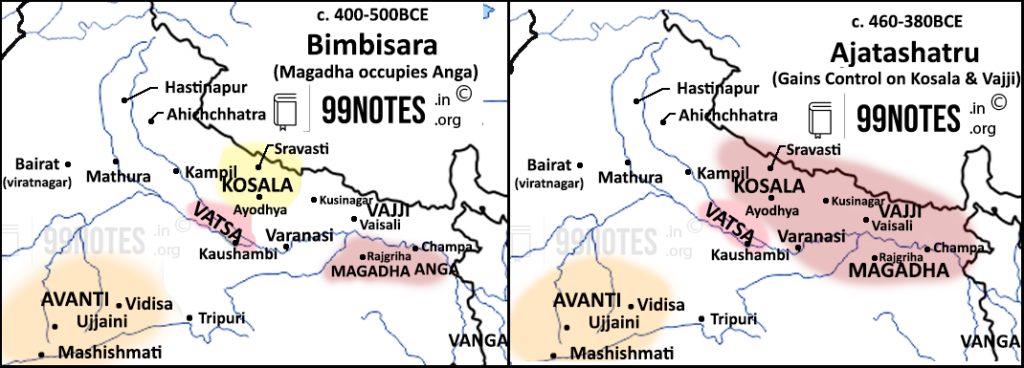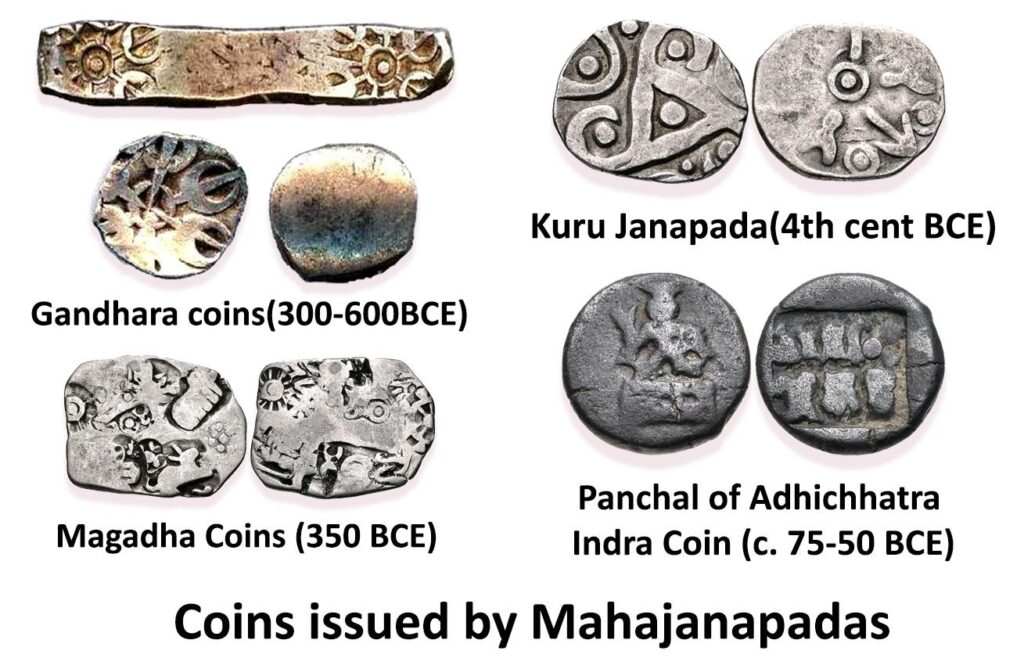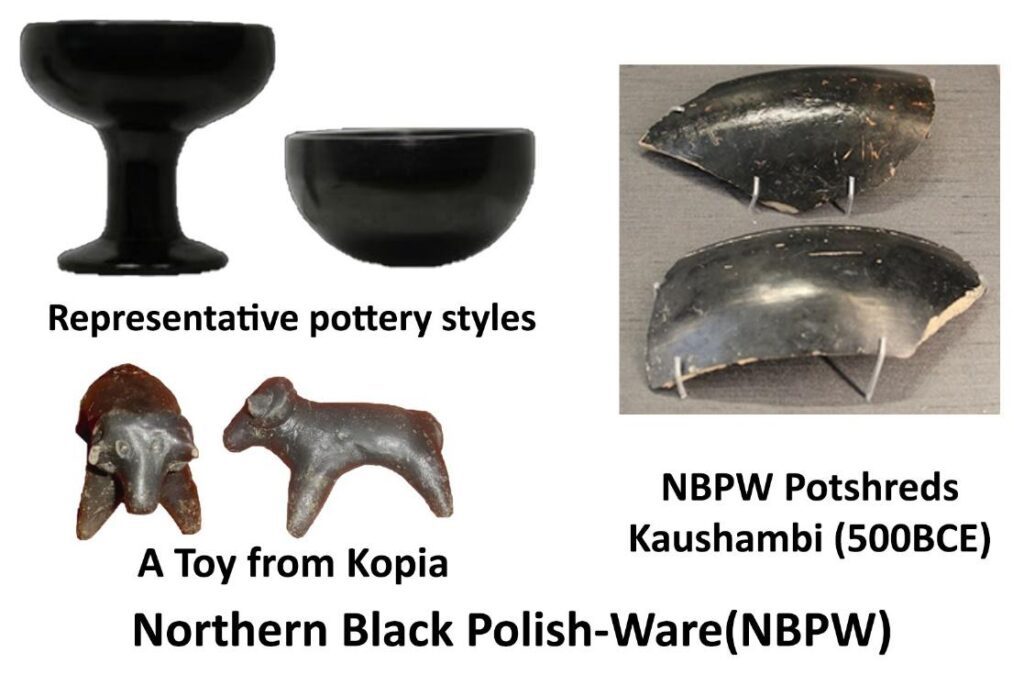Magadha Empire (544-320 BCE): Ancient India’s Glorious Kingdom (Ancient History Notes)
Magadha Empire
- Magadha Empire
- Rise of Magadha Empire
- Haryanka Dynasty (544 BCE-412 BCE)- Magadha Empire
- Sisunaga Dynasty (413 BCE -345 BCE)
- Nanda Dynasty (345 BCE-321 BCE)
- Economy during Mahajanapadas
- Polity and Administration
- Society and Religion
- Material Life
- Conclusion
- Explore additional significant articles on Ancient Indian History listed in the table below:
- FAQs related to Magadha Empire
The Magadha Empire was a significant ancient Indian kingdom, renowned for its contribution to India history and culture. Magadha Empire was Located in Current Day Bihar. Magadha Empire was founded by King Brihadratha, this foundational period, dating back to the 6th century BCE. With time it became a political and cultural hub under the leadership of dynamic rulers like Bimbisara and Ashoka. This empire played a pivotal role in the development of Buddhism and Jainism, offering them royal patronage. The strategic positioning of Magadha, along with its rich natural resources, made it a center of trade and intellectual exchange. Its legacy includes the spread of these religions and the foundation of a centralized governance system that influenced future Indian empires.
Magadha’s eventually emerged as the most powerful empire, which consolidated most of the Mahajanapadas
- It first expanded under the leadership of Bimbisara of the Haryanka dynasty, who started a policy of conquest and aggression, which ended with the Kalinga war during the rule of Ashoka.
- By the end of this phase, Magadha controlled almost all of the Indian subcontinent.
Rise of Magadha Empire
Factors that favored the rise of Magadha Kingdom
- Ambitious rulers such as Bimbisara, Ajatsatru and Mahapadmananda expanded the kingdom by employing all means, fair and foul.
- The Geographical advantage in terms of the availability of the Iron deposits enabled the Magadhan princes to equip themselves with effective weapons. Besides this, the two capital of Magadh, the first at Rajgriha and the second at Patliputra, were strategically located and were virtually impregnable due to surrounding hills and rivers.
- Agricultural Productivity: Immensely fertile alluvial land due to its location at the Centre of the middle Gangetic plain and heavy rainfall significantly increased agricultural productivity and hence generated surplus, which could be mopped up by rulers in the form of taxes.
- Urbanization: The rise of towns and the use of metal money supported trade and commerce.
- Military: Magadha enjoyed a unique advantage in its military organization. They were the first to use elephants on such a large scale in the war against their neighbours. Moreover, they had a constant supply of war elephants from the forests of the Chhota Nagpur plateau.
Over the Course of its existence, Magadha Empire was ruled by various dynasties, each leaving the historical and administrative legacy.
Haryanka Dynasty (544 BCE-412 BCE)- Magadha Empire
1. Bimbisara (558 BCE-491 BCE)
-
- He had his capital at Girivraja/Rajagriha (Rajgir). It was surrounded by five hills, the openings of which were closed by stone walls on all sides. This made Rajagriha impregnable.
-
- He was the first to have a standing army. He started the practice of marriage alliances to strengthen his position.

2. Ajatsatru (492 BCE – 460 BCE)
-
- He killed his own father and captured the throne.
-
- He embraced Buddhism and convened the First Buddhist Council at Rajagriha just after the death of Buddha in 483 BCE.
3. Udayabhadra/UDAYIN (460 BCE – 444 BCE)
-
- He was the son of Ajatsatru.
-
- He moved the capital to Pataliputra from Rajgriha.
Sisunaga Dynasty (413 BCE -345 BCE)
1. Sisunaga
-
- Ended the 100-year rivalry between Magadh and Avanti by destroying Avanti.
-
- Moved the capital to Vaishali from Rajgriha.

2. Kalasoka
-
- He was the son of Sisunaga and was also known as Kakavarna.
-
- He shifted the capital to Pataliputra.
-
- He was killed in a palace feud which brought the Nanda dynasty to the throne.
-
- He is best known for organizing the second Buddhist council at Vaishali.
Nanda Dynasty (345 BCE-321 BCE)
It was the first non-Kshatriya dynasty. They were the most powerful kingdom of their time. Even Alexander, who invaded Punjab then, did not dare to move toward the east. There were reportedly nine Nanda rulers; however, only the first and last are deemed historically significant.
Mahapadmnanda
-
- He became king after murdering Kalasoka.
-
- He added Kalinga to Magadha and brought an image of Jina as a victory trophy.
-
- He claimed to be an Ekarat, i.e. the sole sovereign who destroyed all other princes.
2. Dhananand
-
- He was the last ruler of the Nanda dynasty. He became highly unpopular among his subjects due to his oppressive taxation.
-
- Chandragupta Maurya overthrew Dhanananda with the support of Kautilya, who took advantage of the public resentment against Dhanananda.

Economy during Mahajanapadas
- Metal Technology: The use of iron is the distinguishing feature of this age. The smiths knew how to harden iron tools.
- Agriculture:
-
- With the introduction of Iron implements, rainfed forests could be cleared, and hard-soil areas could be turned using iron-tipped ploughshare, which allowed for large-scale cultivation and settlement.
-
- Further, the immense fertility of the alluvial soil in the newly cleared areas in the Ganga plains contributed to the growth of agriculture.
-
- Rice was the staple cereal produced in eastern Uttar Pradesh. Paddy transplantation, which means saplings were grown and then transplanted in the fields, enormously adding to the yield.
-
- Metal Coins/Legal tenders: Coins made of metal appeared first in the 7th -6th century BCE. The earliest coins are predominantly silver coins though a few copper coins also appear. They are called Punch-marked coins because they were punched with several specific figures, one by one.
-
- They were initially issued by the merchant Guilds and later by the States. They represented a trade currency, a “mark of surety” of future delivery of material. This shows the growth of intensive trade activity and urban development.
-
- The state-issued coins are attributed to two different periods: the first is the Janapadas, and the second is the Mauryans.
-
- These coins draw various natural motifs, like the sun, animal motifs, trees, hills etc., and some were geometrical symbols. However, they carry no script.
-

- Taxation: The warrior and Priest class, i.e., the Kshatriyas and Brahmins, were exempted from paying taxes, and the burden fell on Vaishyas or Grihapatis. Bali, a voluntary payment during the Vedic age, became compulsory, and officers called Balisadhakas were appointed to collect it. Even artisans and traders were taxed.
Polity and Administration
- The Republican Experiment: While most states were monarchies, we hear about a few Gana–Sanghas or republics as well. These were tribal oligarchies which elected the king, and he ruled with the assistance of a council. Shakyas and Lichchhavis were such republics.
- The Decline of Popular assemblies: The territorial kings discarded Sabha and Samiti, and ‘popular assemblies’ lost their relevance.
- The Emergence of a uniform Legal and Judicial System: In place of tribal laws, the Dharmasutras laid down the duties as well as civil and criminal laws according to the varna division.
-
- However, the customs and traditions of non-Vedic tribal groups were not completely ignored, which gradually got absorbed into the Brahmanical social order. As the name suggests, these were written in aphoristic (sutra) style.
-
- Retributive Justice: Rough and harsh punishments were given. In many cases, criminal offences were governed by the idea of revenge.
- Rise of cities: Each Mahajanapada had a capital which used to be fortified.
- Army: Unlike the Vedic age, now the king had a standing army.
Society and Religion
- The Varna Division: The society was divided into four Varnas. The stature of the Brahmans saw a huge rise due to the introduction of more elaborate rituals in the later Vedic texts.
- Challenge to Brahmanas: There is a sense of competition between Brahmans and Kshatriyas for prominence. For example, both Buddha and Mahavira belonged to the Kshatriya clan but ventured into religion, which was the sole authority of the Brahmanas.
- Religion: This period is also known as the age of Buddha. We see the emergence of two important religious sects, Buddhism and Jainism, during this period. They caused several changes in the social and economic life of the people and tried to mitigate the evils that originated from the Brahmanical social order. It opened the doors for women and Shudras.
- Position of Shudras: The varna division of society took a heavy toll on Shudras, who had been relegated to the lowest status in society. They were deprived of religious and legal rights. Even the rise of Buddhism and Jainism did not materially change their position, and their general position continued to be low.
Material Life
- NBPW Phase(700-200BCE): Archaeologically, the 7th century BC marks the beginning of the Northern Black Polished Ware (NBPW) phase. It is representative pottery of the Mahajanapada era in North India. NBPW was a very glossy shining type of pottery and could have served as the tableware of wealthier people.

- Urbanization: The NBPW phase marked the beginning of the second urbanization in India.
-
- However, the structures excavated till now are far less impressive than the Harappan cities. However, they indicate a significant increase in population when compared with Painted Grey Ware (PGW) settlements.
-
- Each town played an important role as a marketplace and came to be inhabited by artisans and merchants who organized themselves into guilds(shrenis) under their respective chiefs. These guilds later developed into Jatis in the post-Mauryan period.
-
- Many cities like Mathura were bustling centres of commercial, cultural and political activity.
-
- The Art of Writing: After the end of Harappan culture, we find written markings only in this period. The Writing led to the compilation of laws and bookkeeping, which was essential to trade, tax collection and maintenance of a large professional army.

- Mathematics and Science:
-
- Shulba Sutras or Śulbasūtras: This period also produced texts dealing with sophisticated measurement (Sulvasutras). However, the earliest records have perished since they were not written on stone or metal. It contains descriptions related to the geometry of the fire-altar construction. There are four types of Shulba Sutras, which are mathematically the most significant. These are attributed to Baudhayana, Manava, Apastamba and Katyayana.
-
- Baudhayana (c. 8th century BCE) composed the Baudhayana Sulba Sutra, the best-known Sulba Sutra, which contains examples of simple Pythagorean triples, such as (3, 4, 5), (5,12,13). Baudhayana also established a way to compute the square root of two, which is the length of a diagonal of a unit square.
-
- Transport and Communication: Nearly all towns were along communication routes.
-
- Pataliputra was located on the riverine route
-
- Ujjaini was located along land routes.
-
- Many cities like Mathura were bustling centres of commercial, cultural and political activity.
-
Conclusion
The Magadha Empire’s enduring legacy is its significant contribution to the cultural and political landscape of ancient India. It not only fostered the growth of major religions but also laid the groundwork for administrative and governance models that influenced subsequent dynasties. Magadha Empire laid the foundation of Akhand Bharat that was later accomplished by various Dynasties like- Gupta Empire, Mughal Empire etc.
Explore additional significant articles on Ancient Indian History listed in the table below:
| Harappan Civilisation | Various Aspects of Harappan Civilisation |
| Stone Age | Decline of Harappan Culture |
| Vedic Period | Persian and Greek Invasions |
| Mauryan Empire | Gupta Empire |
FAQs related to Magadha Empire






